With more than four hundred new cards being added to the game each year, it’s safe to say that card art is one of the most hour-intensive parts of Hearthstone design. And while Team 5 has some amazing in-house artists like Jomaro Kindred and Charlene Le Scanff, even they can’t handle fully designing more than one card per day. That’s why, soon after Hearthstone’s initial couple of cards, Blizzard started outsourcing art to the cream of the crop among freelance artists.
And one of the most popular freelance artists is Matt Dixon, whose art has become synonymous with Hearthstone. Fungalmancer, Hydrologist, Annoy-o-Tron, Snowflipper Penguin… The list of won’t stop growing. But who is the person behind these iconic images? What’s the process behind all these fun, cute and colorful cards? Matthieist had a lengthy chat with the Brit and picked his brain.
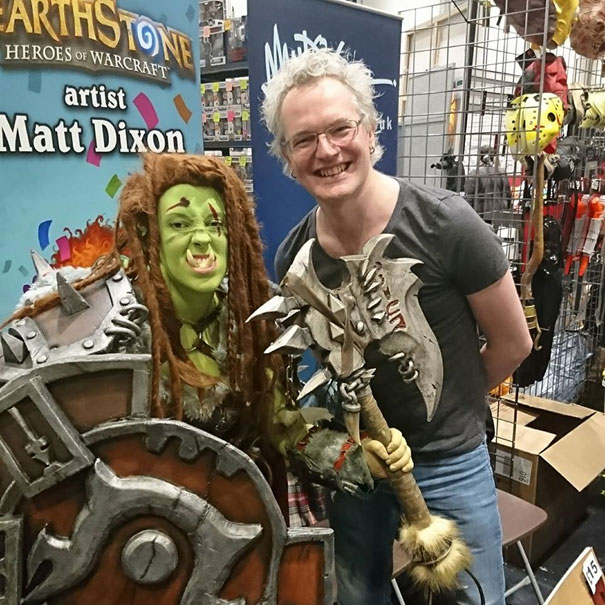
You’ve been an artist for a long time, where did it all start? Who was Matt Dixon before Hearthstone?
It depends where you want to count it from, but my first paid gig was when I was fifteen. At the time I was doing a lot of pixel art on the Commodore 64, so it’s going back a long way now, and it was a shooter game that I got involved with. It just went from building demos to a game – it was a natural progression. But that wasn’t really the start of a career in video games though.
That happened about four or five years later. I kind of lost contact with the guys I’d done that game with shortly after I got an Amiga, an upgrade from the Commodore 64. The Amiga was great, more pixels, more colors to play with, but no modem. So I lost touch with that whole scene, and at the same time I left school, got myself a job and disconnected from the computer a little bit. But years later I got a call from one of the guys I’d done that game with, and they were looking to hire new graphic artists. So they asked me if I was still making pixel art – I wasn’t, but I said that I was – and I borrowed my stepdad’s PC and spent a frantic week before the job interview making some test maps. And I got the job!
I was there for twelve years. When I started I was something like the fifteenth or sixteenth employee, but by the time I left there were nearly three hundred employees. It had grown quite a bit. They did lots and lots of license stuff for games and movies. We did a lot of stuff for Disney’s feature animations like Hercules across lots of different platforms. In terms of games, we did some Crash Bandicoot and Spyro the Dragon games. Not the well known ones though! The last things we did were Harry Potter games and Pirates of the Caribbean.
And then your first gig with Blizzard was the World of Warcraft TCG.

Yeah that wasn’t long after I’d become a freelancer in 2007. I wish there was an exciting story around getting to work with Blizzard, you know? Like a griffin that turned up at home during a stormy night and gave me a scroll or something exciting like that, but it was just an email like all other gigs. At the time I wasn’t even working directly with Blizzard, because the game was published by Upper Deck who did loads of sports trading cards at the time.
So it was just a mass email that had gone out to lots and lots of other artists. There were some really big names on that list as well. That was the moment that I felt… not that I ‘had made it’, but that there was hope for my freelance career. It was really exciting.
But I didn’t know World of Warcraft. I knew of World of Warcraft, but I had never played it, so I didn’t know what I was getting into to begin with.
So you started playing it to get a feeling for the game?

Yes I did, and that was a mistake! [Laughs] It got me hooked, as I think it does with everyone. Maybe the first couple of cards I resisted installing WoW, but after a while I was so enthusiastic about the universe. It’s very similar to my natural style in terms of the way it looks. It’s colorful, it’s over-the-top, filled with big shapes, it’s dynamic… That’s the stuff that I like to work with. So seeing all the artwork and reference material coming through, I just couldn’t resist.
So I installed it, and I lost six months. I mean it’s great, it was a really fun six months. But in the end I had to uninstall the game because it was really knocking my productivity. I mean I play Hearthstone as well, but that’s a much more manageable sort of break. But World of Warcraft, that just eats time doesn’t it?
Some of the art you did for the TCG, like Gadgetzan Auctioneer, ended up in Hearthstone too.
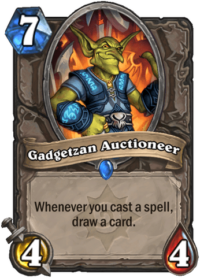
Yup, and that was a complete surprise. So the WoW TCG finished and I thought that was it. I did a lot of work for the game – I think about seventy pieces. So they’ve still got lots of art in the archives that they can continue to use if they want to. And they still are pulling from the TCG, there was some incredible art done for that game.
It was a year or two afterwards that another email popped up asking if I wanted to work on this new game. And it was only after I installed Hearthstone and started looking at the cards that I realized they were using old art. But it’s great, you know? Work that was done ten years ago is leading a new life, which is fantastic. They used one of my TCG pieces in The Witchwood (Curse of Weakness), and it’s always great to see it pop up again. It’s also a bit of a cringy moment, because it’s art from the past and whenever I look at my stuff that I haven’t seen for a long time I tend to criticize it. But you have to get past that, and it’s just great that art, of which I thought it was dead and buried, has been resurrected.
What was it like to be recruited again for Goblins versus Gnomes?
It was completely out of the blue. I can’t remember the exact contact, but it was really casual. I think at that point they were just starting to commission artwork from freelancers. I think Target Dummy was the first piece that I did for Hearthstone. And then Jeeves, and then Annoy-o-Tron. It’s amazing to see that Annoy-o-Tron is still alive, he’s still there, and he’s coming back in Boomsday. I just can’t wait to see him.
On the recent Comic-Con panel about Hearthstone art you said it took you a couple of tries to get used to art specifically for Hearthstone. What made it difficult, or different?

I wouldn’t say it was difficult, but I would say it was different. My approach was to pick up where I’d left with the TGC, but there are a couple of differences. The first is that the TCG was a print game, so even though the cards are small, the resolution is quite high. In Hearthstone, particularly with the minions when people are playing on mobile, those graphics are tiny. From an artist’s technical point of view, the way you compose an image, the amount of detail you can put in there is quite different.
What wasn’t immediately obvious, and what I realized as the feedback for my first pieces came through, is that there’s definitely a different feel. It’s very much in the Warcraft universe, but Hearthstone has its own vibe, its own very distinct flavor. And I think that flavor has grown, it’s gotten a lot stronger as the game has evolved over the past couple of years.
Rather than feeling like there was any kind of struggle, I feel like Annoy-o-Tron was the one when I felt “Ah, there is something new here!” that fit Hearthstone. It’s a card that I revisit from time to time. In terms of flavor and in terms of easy readability it’s a good card to go back to. Even though, even for me, he’s annoying [chuckles].
You’ve got a very distinct style, to the point where during each new expansion’s spoiler season you can already see which of the cards come from your hand. But how would you describe your own style, what makes it unique?

Ooof… Good question. Ehm, I actually don’t know. I’m not an artist that analyzes or thinks too much about what I’m doing. I think I do my best stuff – and I think it applies to all artists – when the conscious brain is off a little bit. You receive an assignment and you’re enthusiastic about it, it gives you this burst of energy and you just want to sit and create. So that tends to be what happens with Hearthstone, I enjoy the work so much. It’s colorful, it’s cheerful, it’s silly… My default expression for any Hearthstone character is a smile or a laugh, because that’s how I’m feeling when I’m painting it.
So I don’t know if that maybe is part of what makes my art distinctive, if it is distinctive. There’s nothing I put in there very consciously, I’m honestly just having fun. I start with that white rectangle in Photoshop and go to town, filling it with as much fun and color and excitement and energy as I possibly can.
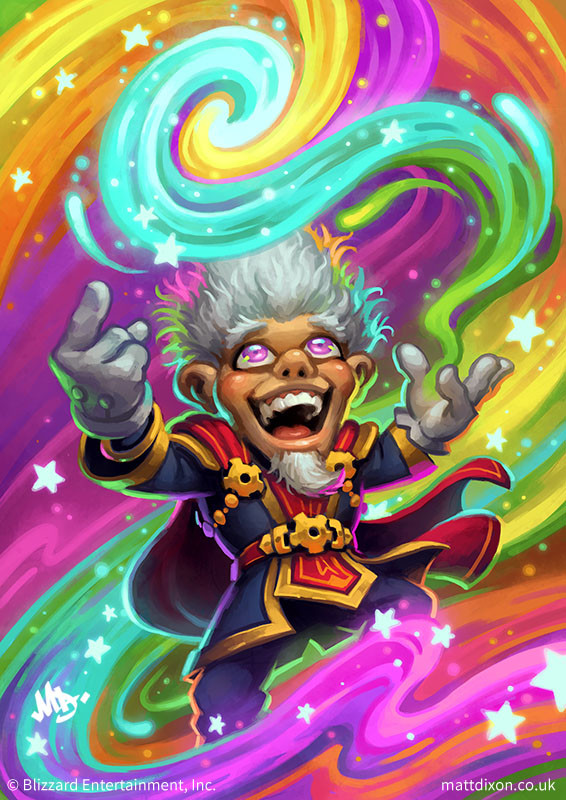
Now, for a brief intermezzo to keep it all fresh, we’re going to change the pace and ask some rapid-fire, non-art Hearthstone questions. Favorite class?
Oh that changes, so… No wait, rapid-fire: Paladin.
Favorite Hero?
I really like Valeera.
Favorite deck?
That’s got to be Quest Shaman. I love Murlocs!
Favorite card?
It’s got to be Annoy-o-Tron.
Favorite card back?
There’s two: Fireside Gathering and Cupcake.
Favorite Hearthstone developer? And don’t say Ben Thompson just because he’s your boss.
[Laughs] I’m gonna say Jeremy Cranford, he’s the art outsource manager. He’s actually the guy who’s between me and Ben Thompson.
Favorite card art, by anyone?
That’s Youthful Brewmaster.
Alright, so much for the rapid-fire questions. I want to expand on that last question: why Youthful Brewmaster?
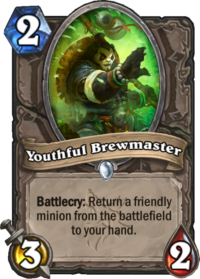
Again, I’m not an artist that analyzes much from other either. There’s something about that card that has me click on it every time I see it, to have the art a little bit closer. It’s just a really good, punchy image. Nice lighting, the character is really solid. It’s a piece of art that just works really well.
I look to all Hearthstone artists for inspiration. All the time. Every time the reveal season kicks off I look forward to seeing the new cards. The whole art style is inspiring to me and it’s fantastic to see what other artists do with the universe, because I obviously have my own take on it. But to see what they do with it is very fun and inspiring, and it pushed me to want to try and do different things as well.
There are a couple of artists that I like in particular. James Ryman (e.g. Sleep with the Fishes, Baku the Mooneater, Archmage Arugal) always, always does amazing work. There is a lot of bright and colorful stuff in Hearthstone which leans towards a cartoony stylized approach, and James manages to get that stylized coloring in there. And I really like Jim Nelson as well (e.g. Tar Creeper, Spikeridged Steed, Mossy Horror).
When you get an assignment from Blizzard, and they tell you something like “This is a butcher gnome”, how do you get started?

So yes the briefings are usually a couple of sentences that describe the character, its race, an action and maybe their emotion. It could be showing ‘Angry gnome butcher chasing a Murloc’. It’s just a couple of sentences which leaves a lot of space for the artists to work with. We also get some reference material. Think of model sheets of that particular character to remind us what the proportions of a gnome are, there might be screenshots from World of Warcraft or even just concept art. It gives us a really good base from which to work.
We also receive a style guide for that expansion, which are about two dozen of pages with ideas and the flavor for that expansion.
For me, that’s the routine, absorbing all the information. Then put on some appropriate music and just paint. The music’s got to fit with the character that I’m painting. If it’s a Murloc, I’ll listen to something jolly and cheerful, maybe a bit silly. If it’s a Mech or a huge legendary it’ll be something more epic. I really find that the right type of music gets me in the right mood. It’s usually rock, but there’s space in there for disco as well you know? Gnomes are disco.
What are some pieces which instantly clicked for you, and what were some that were more difficult to get a satisfying concept for?
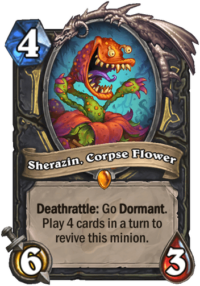
Ehm… usually the description will prompt an idea. I found that ideas are usually very easy to come by. It’s finding ideas that work that’s the problem, and that tends to happen when I just start drawing. So the music’s on, I’m sitting down in front of Photoshop and I just start to draw. And sometimes that initial idea just works. It starts off really loose, messy and scribbly, and then over time it comes into focus, almost. That first sketch starts to come together.
But sometimes it doesn’t work. I don’t have an example, and I think the reason for that is that the initial creation process is so frantic. I sit and I work until something works. So sometimes I can sit down and if that initial idea is going to work I’ll have a sketch ready to submit to Blizzard within a couple of hours. Other times I’ll sit down first thing in the morning and I’m still there in the evening, working on that same piece, tearing away at it. I don’t really stop until I find something that works. There have been many many pieces that have taken a long time in order for me to find that composition, that right expression.
A card like Sherazin, Corpse Flower was one that just worked. The idea was just to go for that man-eating plant design. And the first few lines that I put down were the framework that the rest of Sherazin build on top of. The more difficult part was the Seed (Sherazin, Seed, because it’s a two-stage card. So we’ve got the open flower with its crazy expression and its googly eyes, and I had to package it inside the leaves. Because I was so enthusiastic and happy that the initial sketch was working I ran with it without considering how I was fold him back up. Sherazin, easy. The seed, despite it being a simple illustration, it took some time to find a way to pack him away and still give it personality.
At the start of the interview I asked you who Matt Dixon was before Hearthstone. But who is Matt Dixon now? What has changed?

Oh, interesting one. I don’t think it has changed me that much, but it certainly changed the audience for my work. Because Hearthstone has been such a success it has brought a lot of people to my work who otherwise wouldn’t have found it. It’s also slightly changed my freelance life because they are happy to send me plenty of work – thankfully – as it occupies an enormous amount of my time. Which is fantastic. To have that regular gig. Normally a freelancer’s life means lots and lots of different things. And that’s great, that’s part of the appeal, that variety.
Hearthstone, while it doesn’t occupy all of my time, it’s probably a good fifty percent. It allows me to get a lot more intimate with the gig than a freelance artist would normally be able to get. Usually you do something and it might come back six months later, but to have the regularity of something like Hearthstone means I understand the universe much better. It’s the best of both worlds. Working in-house is great because you’re working with a regular team and you can share some of the successes you have and you build relationships where you can have natural conversation with the people you’re working with. Freelance gives you that variety.
Hearthstone is a perfect mix of the two. I get that relationship and understand the product much better than I would do under normal circumstances, but I’m also free to do other stuff. I can get a break from when I’m perhaps having a little bit too much fun.

Love this artist. His pieces are among my absolute favorite in Hearthstone.
Great piece, fun read.
One of my favorite artists regarding hearthstone.
Cool you guys made an interview.